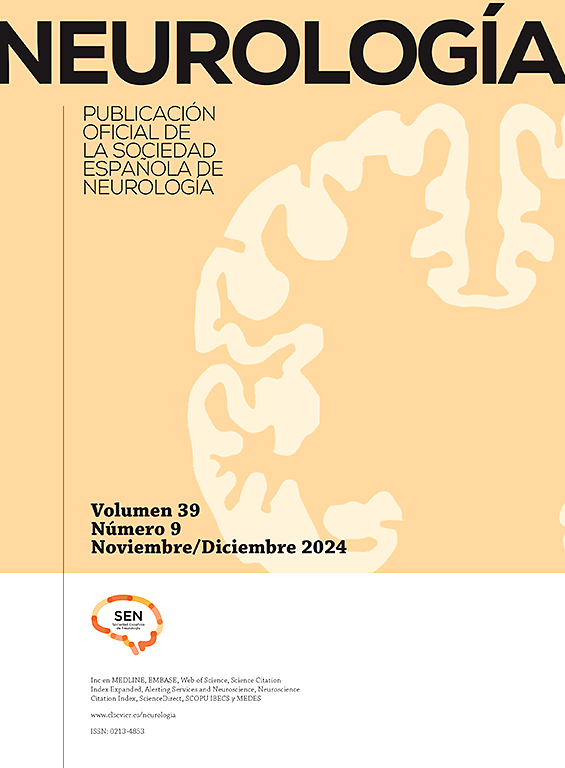帕金森氏症和其他运动障碍的姑息治疗。多学科专家组的建议和议定书
IF 3.1
4区 医学
Q2 CLINICAL NEUROLOGY
引用次数: 0
摘要
目前帕金森病(PD)和其他运动障碍(MD)面临的挑战之一是如何以及何时应用姑息治疗。意识到这种方法缺乏培训和实施,我们提出了一些关于姑息治疗(PC)的共识建议,以改善患者的生活质量和他们的环境。材料和方法通过对西班牙神经科医生的调查和文献回顾进行第一阶段的需求分析后,我们描述了以下方面的行动建议:姑息治疗模式,目标人群的选择,何时,何地以及如何实施PC。结果回顾了神经姑息治疗的模式,提倡神经科医生作为推动力量的作用。描述了多学科团队的成员,以及帮助临床医生决定哪些患者有更大的姑息治疗需求的主要临床标志和工具;定义了发送者和接收者,并详细说明了将患者送到姑息治疗时的进化时刻和如何进行。提供了任何个人护理协议(无论是基本的还是专门的)应遵循的步骤方案,强调了共享护理规划和综合方法的框架。结论将神经姑息治疗整合到PD和其他MD的治疗中,并在我们的环境中验证神经姑息治疗模型,通过指标分析其实用性,以提高患者的护理水平和生活质量。本文章由计算机程序翻译,如有差异,请以英文原文为准。
Cuidados paliativos en enfermedad de Parkinson y otros trastornos del movimiento. Recomendaciones y protocolo de un grupo multidisciplinar de expertos
Introduction
One of the current challenges in Parkinson's disease (PD) and other movement disorders (MD) is how and when to apply palliative care. Aware of the scarce training and implementation of this type of approach, we propose some consensual recommendations for palliative care (PC) in order to improve the quality of life of patients and their environment.
Material and methods
After a first phase of needs analysis through a survey carried out on Spanish neurologists and a review of the literature, we describe recommendations for action structured in: palliative care models, selection of the target population, when, where and how to implement the PC.
Results
Models of neuropalliative care are reviewed, advocating for the role of the neurologist as a driving force. The members of the multidisciplinary team are described, as well as the main clinical markers and tools that help the clinician to decide which patients have greater palliative needs; sender and receiver are defined and it is detailed in what evolutionary moment and how to proceed when sending the patient to palliative care. A scheme of steps to follow in any PC protocol, whether basic or specialized, is provided, emphasizing the framework in the shared planning of care and the comprehensive approach.
Conclusions
It would be desirable to integrate the PC in the management of PD and other MD and to validate models of neuropalliative care in our environment, analyzing their usefulness through the use of indicators, in order to improve the care and quality of life of our patients.
求助全文
通过发布文献求助,成功后即可免费获取论文全文。
去求助
来源期刊

Neurologia
医学-临床神经学
CiteScore
5.90
自引率
2.60%
发文量
135
审稿时长
48 days
期刊介绍:
Neurología es la revista oficial de la Sociedad Española de Neurología y publica, desde 1986 contribuciones científicas en el campo de la neurología clínica y experimental. Los contenidos de Neurología abarcan desde la neuroepidemiología, la clínica neurológica, la gestión y asistencia neurológica y la terapéutica, a la investigación básica en neurociencias aplicada a la neurología. Las áreas temáticas de la revistas incluyen la neurologia infantil, la neuropsicología, la neurorehabilitación y la neurogeriatría. Los artículos publicados en Neurología siguen un proceso de revisión por doble ciego a fin de que los trabajos sean seleccionados atendiendo a su calidad, originalidad e interés y así estén sometidos a un proceso de mejora. El formato de artículos incluye Editoriales, Originales, Revisiones y Cartas al Editor, Neurología es el vehículo de información científica de reconocida calidad en profesionales interesados en la neurología que utilizan el español, como demuestra su inclusión en los más prestigiosos y selectivos índices bibliográficos del mundo.
 求助内容:
求助内容: 应助结果提醒方式:
应助结果提醒方式:


